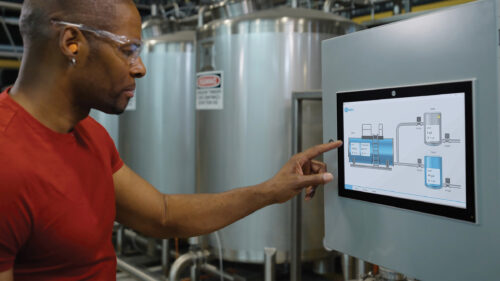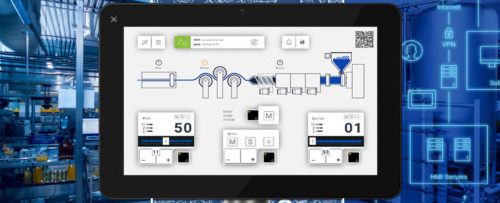Hot process jacketing
Jacketing or providing heat for piping in hot processes can be achieved in several ways: steam tube tracing, fully jacketed piping, and bolt-on jacketing.
Chris Grice, Controls Southeast, Inc., Charlotte, NC
Key concepts
Jacketing is more efficient than tube tracing.
Bolt-on jacketing can be done while piping is being installed.
Bolt-on jacketing saves cost and maintenance. A recent retrofit of the piping system in an asphalt handling operation sheds new light on the age-old issue of how best to maintain line temperatures in hot processes with relatively wide temperature ranges.
Choice of both heating medium and type of heat distribution system can make a surprising difference in uptime, process control, energy cost, and maintenance cost.few feet of plain copper tubing around the pipe, and then run a hot fluid through it?
Then the system starts up and the operator accepts the results; however good or bad. Forgotten are the future energy bills as well as limited temperature control, scrap rates, downtime, repair costs, and incomplete melt-out afeeter shutdown.
That was exactly the situation at a midwestern insulation manufacturer that used hot asphalt as a binder in their laminating process. The asphalt bonds the vapor barrier to the fiberglass mat. The existing system used a patchwork of fully jacketed piping and steam tube tracing to keep the asphalt hot and flowing.
Flow alternated between liquid and blobs, which was deemed to be okay, even though it spoiled a couple of thousand dollars a month worth of product. Operating management simply was not aware it could be any better.
The asphalt transfer system, involving about 1200 lineal feet of 3-inch piping, distributes the hot asphalt to five processing lines. Valves permit shutoff of the asphalt at any idle processing line. Process temperature in the old system ranged between 150 F and 350 F, depending on ambient temperatures, location in the system, and the plant’s operating rate. The supply tank and the first 200 feet of piping were outdoors; the balance indoors.
In an effort to reduce plant-wide energy costs, senior management decided to convert the entire plant from steam to a closed hot-oil system. The planned conversion was triggered by an outside study that projected switching heating media would reduce energy costs by about 40%.
The move certainly seemed worthwhile on paper. Moreover, oil systems typically operate at a lower pressure than steam systems and properly designed oil systems are known to require less maintenance than steam.Nevertheless, the decision left plant engineers in the asphalt handling section in a bind. They had to find another way to keep the asphalt hot and flowing.
Their original idea for a replacement system was to simply run hot oil through the existing steam lines. However, a study revealed that the entire existing system, a combination of both jacketed piping and trace tubing, needed replacement. The insulation was in bad shape and both the unjacketed and jacketed asphalt piping leaked.
Energy losses and mounting maintenance and housekeeping headaches would have cut into the expected savings. It could have been kept working, but at a very high cost.
Start from scratch So the search began for a completely new thermal maintenance system. The company reduced the choices to either a new tube tracing system or bolt-on jacketing. Fully jacketed piping was ruled out as unnecessarily expensive overkill.
Estimates showed that the bolt-on system would cost about 40% less than fully jacketed piping and fit in a smaller physical envelope. Additionally, it would be more energy efficient, much more reliable, and would maintain a more predictable temperature profile than tube trace. Finally, it would also offer a 4 hour or less warm up/recovery time, and not the hours, or in some cases days, required for tube tracing.
Recommendations were based on estimates and previous experience with both types of systems. Copper tubing is inexpensive, but fitting it snugly to pipe in the field is a very uncertain, skill-intensive operation, which can really run up the total installed cost.
Also, once the line is up and running, heat transfer efficiency depends greatly on how closely the tubing contacts the pipe. At best, it is point contact and once thermal growth occurs, the chance of maintaining contact between the tubing and the pipe is very suspect.
Greater contact area is the main reason for the huge difference in thermal efficiency between tube tracing and bolt-on jacketing. Bolt-on jacketing contacts the pipe over its total area, while copper tubing makes contact only at the tangent point.
A known contact area establishes predictable thermal performance and explains the much faster recovery time and 30% to 60% higher thermal efficiency of bolt-on jacketing over tube tracing, whether the medium is steam or hot oil.
The operator agreed with the bolt-on recommendation and $180,000 of piping was installed. All the piping is covered with bolt-on pipe jacketing and the new valves are jacketed with standard bolt-on jacketing to fit each particular valve.
Installation time for the entire jacketing system was about three weeks, and was concurrent with the schedule for the process piping itself. Tube tracing, by contrast, can be done only after the piping is done. New system The asphalt supply system operates as a closed circuit, with individual loops running off the main line to serve each of the five production lines. It uses 200 gallons of heating oil. The temperature is maintained at 369 F , plus or minus 5 F.
Shut off valves on either side of the dispensing nozzles in each loop make it easy to turn the asphalt supply on and off to match laminating line production cycles. When the line is running, so is the asphalt.
The jacketing system matches the asphalt supply system in operating flexibility. When the asphalt is turned off to a particular loop, so is its heating oil, substantially reducing energy costs.
Hot oil is fed into the system at 17 separate areas to keep temperatures consistent throughout. This involved analyses to carefully balance the heat duty and pressure drop of the oil system.
The new bolt-on thermal maintenance system was projected to pay back its initial cost out of energy savings in less than a year. It has run trouble-free ever since startup.
The system maintains temperature at 369 F throughout the active parts of the system, regardless of outside temperatures or which laminating lines are running. Production personnel can restart a cold, idle asphalt line and be back up to temperature within 4 hours.
Energy and maintenance savings aside, the company is saving a substantial amount of money per month in reduced scrap. The asphalt flows so uniformly that all scrap associated with blobs and chunks of asphalt have disappeared. Comparisons Under tube tracing, the installed cost would have been about $25,000 lower. However, heat transfer efficiency would have been 40% lower and maintenance costs would have been very much higher. Elimination of lumps could not be guaranteed with tube tracing, making any scrap rate savings very uncertain.
No tube tracing system could provide 4 hour recovery from a cold startup. From experience, recovery would more likely take a day or more. This is the biggest benefit of all.
Bottom line: the company could have saved $25,000 in installed cost with tube tracing once but would have lost out on at least $100,000 a year in maintenance costs and lower yields for years to come.
The installed cost for a fully jacketed system would have run approximately $300,000, which is 66% higher than bolt-on jacketing. Heat transfer efficiency would be very much higher, but recovery time would be only slightly quicker: 3 hours vs. 4 hours.
Fully jacketed piping also requires a lot more engineering than bolt- on jacketing, including specialized stress analysis. With bolt-on jacketing, only stress analysis for simple unjacketed piping is needed.
Another big difference between bolt-on and fully jacketed piping is the heating oil volume requirement. For a comparable heat rate, fully jacketed piping requires 75% more oil than bolt-on jacketing. At more than $30/gallon in the system, it’s not a forgettable sum. It also means 75% more oil to heat, pump, and store.
In a process as forgiving as asphalt transfer or transportation, fully jacketed piping shouldn’t be considered seriously anyway. It is best suited for difficult hot processes with extremely high temperatures, very tight temperature windows, and ultra-quick recovery requirements. And in the event of cross contamination, in many cases the piping must be discarded due to the inability to re-use it.
Asphalt processors, paving companies, roofing plants, and other industrial users have traditionally used fully jacketed piping. Refineries sometimes settle for tube tracing, due to the long transfer line and resultant high cost of fabricated jacketed piping.
Also, steam is plentiful in refineries and energy is regarded as essentially free since the processor doesn’t have to buy his fuel. While bolt-on jacketing probably cannot always be justified in a refinery from an energy savings point of view, lower maintenance costs, reliability, and elimination of cross-contamination risks are the key points for consideration. Energy savings is certainly justifiable in paving plants and industrial operations that use asphalt.
At the subject insulation plant engineers specified bolt-on jacketing for the new valves in the system. That was very smart. It eliminated all the risks of valve failure due to improper welding of jacketing onto valves.In the worst case, a valve can torque itself to death, twisting the stem in two, because of distortion of the body caused by thermal stresses set up during welding of the jacket.
In most cases, the problem with pipe fabricators welding on a valve is the failure to realize that a valve is a precision mechanical device. It has moving parts. Those stems and plugs must move precisely and in very tight clearances between the moving parts and the body.
Improper welding can introduce stresses that distort the parts, overheat the packing or even alter the microstructure of the base metal. The valve leaks, or freezes up. If you must use a weld-on jacket on a valve, be sure the jacketing is done by an ASME code facility that follows ASME welding practices specifically for valves.
The differences in installed cost between bolt-on jacketing and tube tracing have been interesting. Some plants have received competing bids for tube tracing on a time and materials basis. The only numbers shown are the material cost of the tubing and the bolt-on units.
A $6,000 price for tubing sure has an appeal vs. a $30,000 price for bolt-on units to do the same job. But material cost is less than half the story. Other bids for installed tube tracing can range from 20% under to 10% over bolt-on jacketing for the same job.
The other problem with tube tracing is that there is no engineering, and no way to predict with confidence the thermal efficiency, consistency, and energy cost. These recurring costs will far exceed the capital cost, and particularly the capital cost differential between bolt-on jacketing and tube tracing.
Although bolt-on jacketing has been a proven thermal maintenance solution for more than 25 years, it may be new to operators and specifying engineers on more forgiving processes.
More info For more information about jacketing pipes and valves, contact the author. He can be reached at 704-644-5000 x5005. Article edited by Joseph L. Foszcz, Senior Editor, 630-288-8776, jfoszcz@reedbusiness.com .
Do you have experience and expertise with the topics mentioned in this content? You should consider contributing to our CFE Media editorial team and getting the recognition you and your company deserve. Click here to start this process.





